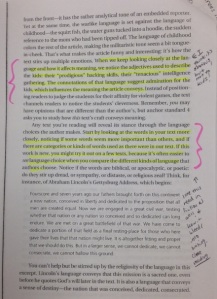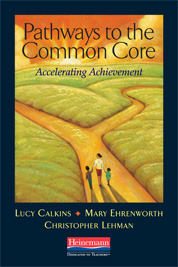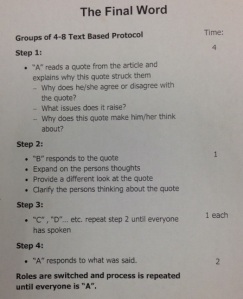For a week this summer, a group of teachers from my district are coming together as a literacy leadership team to study the common core, work on nonfiction units, and plan professional development for the district for the school year. Today we were reading a section from Pathways to the Common Core, the text Lucy Calkins Co-authored with Mary Ehrenworth and Christopher Lehman about the new standards.

We read a section about Nonfiction reading, and then broke up into small groups and did a protocol called “The Final Word.” Text-Based protocols like this one help to facilitate a conversation that stays more targeted and equitable than you sometimes get when you have an unstructured conversation.
The small, focused reading selection, combined with the protocol, helped me to cement what the text was saying. I read Pathways last year when it came out (free gift from the summer reading institute at TC!), but while I enjoyed the text, I couldn’t absorb it fully with one reading. The writing is so clear, you can mistake it for light reading. It’s actually quite dense, and the kind of information you need to read multiple times, probably in small chunks. I was happy to have the opportunity to read it again.
Reading the chapter reminded me of a few key ideas:
Before you teach your students, first practice out what you want them to be able to do as an adult reader or writer.
The first time I saw this idea was in Mosaic of Thought, by Keene and Zimmerman. They wrote about trying to grasp a dense piece of poetry as adults, and then thinking about what strategies they used to comprehend the piece and teaching those strategies to children. Pathways also uses this strategy, working through a model text, Killer, from The New Yorker, as a way to show educators what the Common Core Standards look like in practice.
Nonfiction standards mirror the fiction standards.
It’s really kind of beautiful. The headings are actually the same:
Key Ideas and Details
Craft and Structure
Integration of Knowledge and Ideas
Range of Reading Levels and Text Complexity
Within the headings, the standards are often identical as well.
Informational reading standard 4.1: Refer to details and examples in a text when explaining what the text says explicitly and when drawing inferences from the text.
Literature reading standard 4.1: Refer to details and examples in a text when explaining what the text says explicitly and when drawing inferences from the text.
The same is true for the majority of the standards. The idea that the strategies a reader / writer uses for literature are often transferrable to informational texts allows us to be much more coherent in our teaching across the year. It doesn’t have to be a total switch in our style of teaching and tasks when we move from literature to informational. It will look different with the different texts, but we can be explicit with students how they’re taking skills they’ve already learned and using them on a new type of reading / writing.
Reading with a purpose and talk support comprehension
I had read this text before today, but reading it again, with the idea that we were then going to discuss quotes that stood out, gave me a new purpose with reading. I read more closely and carefully than when I’m reading on my own. The resulting discussion with the protocol made me slow down even more, and consider the quotes that everyone shared more carefully. And it was fun! It was another reminder of how important it is for our students to know why they’re reading, to be able to talk to support their comprehension, and to have that talk be supported with structures (such as protocols, sentence stems, or procedures for contributing and sharing the floor.)
Calkins also mentions a companion video that readers could look at along with the Killers article called The Great Office War to help compare and contrast. It’s pretty awesome, and a reminder that all of this work can be extremely engaging and fun with the right texts.


Leave a comment